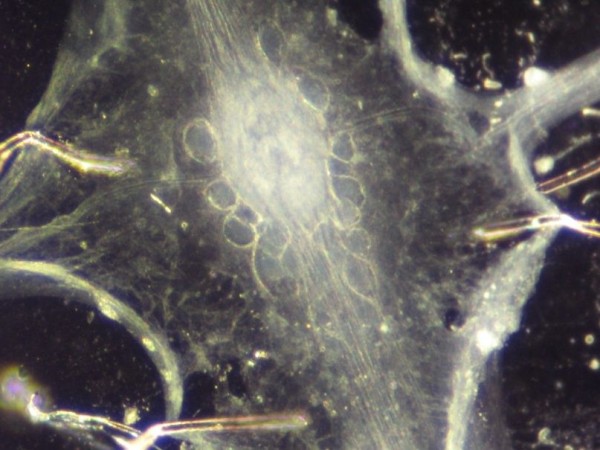New Information on Neurons Could Lead to Brain Disorder Advancements
| Marc Maligalig | | Oct 15, 2014 03:03 PM EDT |
(Photo : Wikimedia Commons) The stomatogastric ganglion of the Jonah crab
Researchers from the University of Missouri have discovered that individual neurons respond differently to electrical signals at the molecular level and in various ways, even among nerve cells of the same kind.
The differences between the cells may become crucial in finding out the underlying problems linked with neural diseases and brain disorders such as epilepsy.
Like Us on Facebook
"Genetic mutations found in neurological disorders create imbalances in the inward and outward flow of electrical current through cells," said David Schulz, associate professor in the Division of Biological Sciences in the College of Arts and Science and a researcher in the Interdisciplinary Neuroscience Program at MU. "Often, neurons react to electrical signals, or voltage, and compensate by altering their own electrical outputs.
He added that the deviation on the imbalances, even among the a number of neurons of the same type in the brain, is one of the prominent issues researchers face when trying to create therapies for illnesses like epilepsy.
Seizures in individuals can be caused by different imbalances - therefore getting to the root of how neurons act individually makes our studies important," Schulz said.
Schulz and his colleagues had proven before that a pair of identical neurons are able to attain the same electrical activity in various ways. Schulz, in the new study, hypothesized that nerve cells might use the cell's genetic code, or its messenger RNA, to "fine tune" the creation of proteins, aiding separate cells respond accordingly.
By using clusters of brain cells taken from Jonah crabs, the research team experimentally changed the electrical output and input of the neurons and measured the levels of messenger RNA found inside the cells. Schulz said that while the invertebrates such as crabs are useful in the field of neuroscience because their brain cells are easy enough to monitor and study, they are complex enough that the results can be "scaled up" to apply to higher organisms.
The scientists discovered that when normal patterns of stimulation were sustained, the neurons used the correct proportions of mRNA to create the proteins required to help keep the electrical impulses in order. However, when ordinary of activity were not supported, it led to a fundamental change in the cells at a molecular level.
"We were the first to show that the correct ratios of mRNAs are actively maintained by the actual activity or voltage of the cell, and not chemical feedback," Schulz said. "These results represent a novel aspect of regulation that might be useful for developing therapeutics for neuronal disorders later."
Tagsneurons, brain, Neuron, Nerve cells, Brain cells, Messenger RNA, mRNA, Electrical signals, Brain disorders, Brain illnesses, brain function
©2015 Chinatopix All rights reserved. Do not reproduce without permission
EDITOR'S PICKS
-

Did the Trump administration just announce plans for a trade war with ‘hostile’ China and Russia?
-

US Senate passes Taiwan travel bill slammed by China
-

As Yan Sihong’s family grieves, here are other Chinese students who went missing abroad. Some have never been found
-

Beijing blasts Western critics who ‘smear China’ with the term sharp power
-

China Envoy Seeks to Defuse Tensions With U.S. as a Trade War Brews
-

Singapore's Deputy PM Provides Bitcoin Vote of Confidence Amid China's Blanket Bans
-

China warns investors over risks in overseas virtual currency trading
-

Chinese government most trustworthy: survey
-

Kashima Antlers On Course For Back-To-Back Titles
MOST POPULAR
LATEST NEWS
Zhou Yongkang: China's Former Security Chief Sentenced to Life in Prison

China's former Chief of the Ministry of Public Security, Zhou Yongkang, has been given a life sentence after he was found guilty of abusing his office, bribery and deliberately ... Full Article
TRENDING STORY

China Pork Prices Expected to Stabilize As The Supplies Recover

Elephone P9000 Smartphone is now on Sale on Amazon India

There's a Big Chance Cliffhangers Won't Still Be Resolved When Grey's Anatomy Season 13 Returns

Supreme Court Ruled on Samsung vs Apple Dispute for Patent Infringement

Microsoft Surface Pro 5 Rumors and Release Date: What is the Latest?










